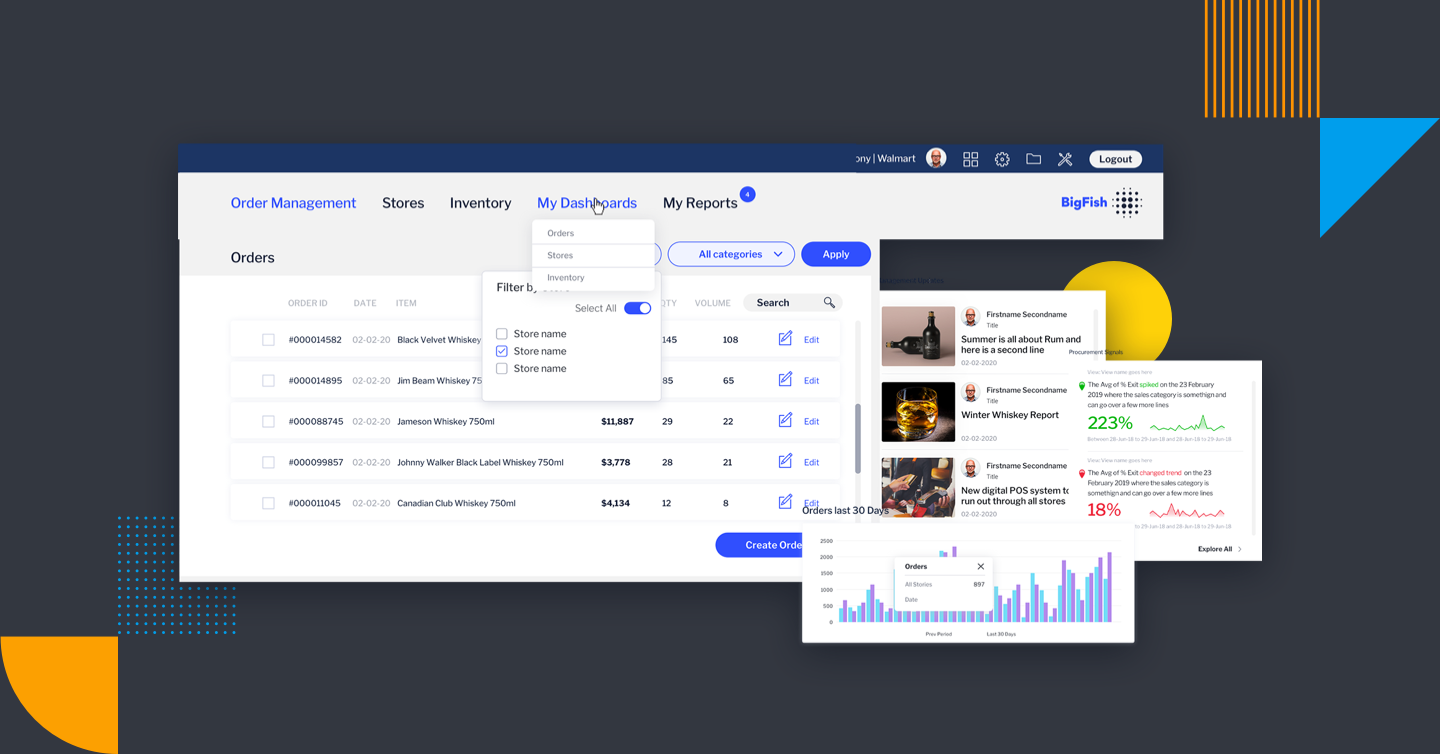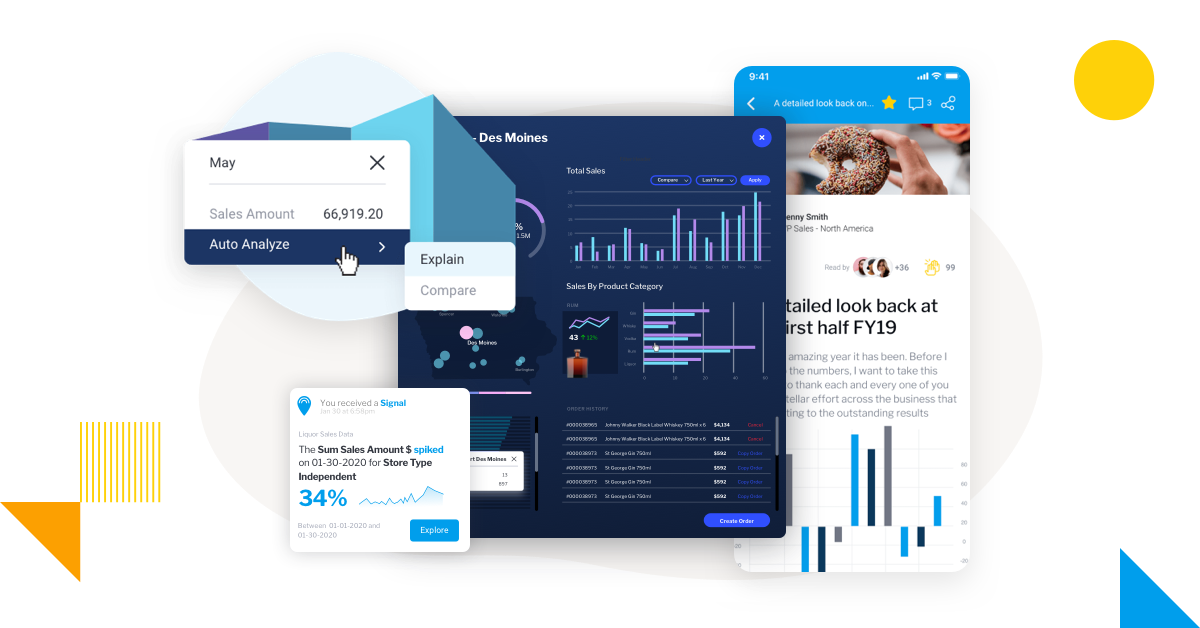In this blog, we cover 4 must-have analytics features your users need to find more actionable insights from their BI, and how each are transforming data discovery for the long-term.
Actionable insights are the end-goal of adopting an analytics platform, but many businesses still have a hard time finding the signal through the noise.
Data is constantly growing in complexity and quantity, and ensuring your users find reliable answers from their dashboards and reports for informed decision-making can be difficult if you don't actively guide them on how to use the analytics tools you provide.
The problem is most BI solutions on the market today still tailor their tools to analysts first, and other issues, like disparate data sources, static dashboards and noisy data, complicate the search for actionable insights for regular users. This results in:
- Businesses still spending time and money for analysts to interpret their data for them
- People finding it hard to explore, understand, and extract answers from their data
- Users eventually making decisions based on misinterpretations or guesswork anyway
Yellowfin is changing this approach. We've built out several analytics capabilities, from automated alerting to machine-assisted explanations to contextual dashboards, that help surface, bring together and explain the ‘why’ behind their data. This is to make it easier for everyone in a business understand and unearth insights they can act on.
#1 - Automated business monitoring: Reliable insight discovery
Dashboards are great, but aren’t cutting it anymore when used as the only solution for BI.
It’s impossible to scan every report manually, and unrealistic to expect people will always be able to understand the data they explore or spot relevant changes on a dashboard without guidance. They may misinterpret data, or miss important trends altogether.
Automated business monitoring (ABM) removes a lot of the difficulties associated with traditional manual analysis of static dashboards, by automating the data discovery process to spend less time digging for patterns.
- Continuously monitor and run analysis on operational data
- Detect and surface critical information that is most relevant to users’ needs
- Auto-alerts users to anomalies, changes and trends as a guide on where to act
Yellowfin incorporates ABM through its Signals product, which employs pattern detection heuristics, machine learning and real-time data monitoring to automatically identify statistically significant deviations in data. Identified patterns are then processed across all datasets, looking for additional relevance. This means instead of manually-defined, static thresholds to trigger action, Yellowfin continuously scans for and delivers critical changes in data, directly to users - saving time and revealing hidden nuances.
ABM ultimately brings more context your users need to make findings actionable. Its real-time monitoring means businesses always know what is happening, as it happens, and the system itself does the heavy-lifting to point people in the right direction. Most importantly, it makes analytics and finding actionable insights more accessible for all.
Learn more: 5 key business benefits of Automated Business Monitoring
#2 - Natural language: Explaining the meaning behind the data
A typical dashboard packed with visualizations and metrics can present a complex, timely challenge when the average user needs to dig through their data to try and glean answers. While they are great sources for day-to-day operational monitoring or slicing and dicing, its self-service nature means the cause of results isn't always explained.
This is where natural language comes in, employing machine-learning (ML) to instantly generate text-based explanations and accompanying visualizations (graphs, tables), that translates what the data means in an easy-to-understand summary. The user can then choose the provided answers they want to build upon or define further before acting.
But why is natural language a must-have feature to have in an analytics solution?
- Points users toward hidden nuances and unseen patterns they may not find
- Provides helpful extra context that guides the user toward what is actionable
- Saves time and effort on repetitive reporting tasks by generating analysis quickly
- Supplements the user’s existing knowledge with more detailed information
![]()
Yellowfin uses natural language in its Assisted Insights feature, available to use within dashboards and reports with the click of a button to explain or compare two data points; the user is then provided with auto-generated charts and narratives in the same window. It’s easy, seamless and reduces reliance on having to ask analysts for more explanation.
Learn more: What is natural language generation?
#3 - Data storytelling: Bringing data and insights to life
Dashboards and reports are critical components of any BI solution, but to understand deeper context behind the metrics that can lead to action, a narrative is required.
With the rising complexity of data, users need tools in their analytics platform to help build a narrative around an important insight that engage stakeholders emotionally, provide depth of understanding to a discovery (eg. contextual information like expert opinion, past experiences), and back it up with hard data to drive better decisions.
Being able to support dashboards/reports with storytelling is invaluable for two reasons:
1. Some strategic decisions can’t be drawn from what the data shows alone. Important insights need a backstory and narrative to transform the discovery from a collection of numbers to something people will care about, which will encourage action or response.
2. Facilitating the best course of action on an insightful discovery requires data and storytelling tools that can help make the shared narrative emotionally engaging to readers. Being able to excite, inspire and surprise people not only helps incite people to act, but align decision-makers on the most appropriate action to take going forward.
For helping unify interpretations and finding the nuance in data, storytelling capability is key to unlock more actionable insights heading forward. In fact, data stories are predicted to be the most widespread way of consuming analytics by 2025 (via Gartner).
Data storytelling is a significant component of the Yellowfin suite, which offers two products: Yellowfin Stories, an in-built tool that allows users to write and share insights in a news-like, blog-style format for long-form narratives; and Yellowfin Present, for users that require a presentation format to take an audience through the context with a story.
Discover more: What is data storytelling? The value of context
#4 - Contextual analytics: Dynamic analysis, alerts and insights
Embedded analytics solutions have made it easier for many users to have better access to their data and self-service reporting by bringing analytics into their software as its own component. However, here analytics is still a standalone module, so there’s no guarantee people will use it or find actionable insights they can use for decisions.
Contextual analytics is a more sophisticated form of embedded BI that embeds analytics directly into an application’s transactional environment and operational processes, making analytics now a part of the user’s experience with the core software. Think charts, metrics, tables, even entire dashboards displayed right next to your application’s core components. It places helpful BI features right in front of the user, as they work.

This means when users can access relevant data and insights right at the point in time they are needed to assist in their next action, and gain instant, guided, dynamic insights delivered directly to them, bringing huge benefits to BI users in finding more insights:
Dynamic insights: Pop-up alerts, in-line charts and dynamic visualizations can present themselves based on the user’s past actions (personalization) directly in the user’s regular workflow within the application, prompting them to act on a discovery.
Guided analysis: The analytics component embedded into your product itself now proactively guides people to use your software more competently, and use the data now readily available as part of their workflow, to consistently drive their decisions.
Increased relevance: Because analytics now supports decisions and triggers actions inside an app’s transactional workflows, it reduces extraneous data and time spent manually exploring, and delivers more information related to what users want to do.
Contextual analytics is core to Yellowfin’s offering, and intertwines with every part of its suite to ensure users have powerful analytics right at their fingertips when using your software that is guided and explained to them. They don’t have to go anywhere else to find relevant insights to inform their decision-making, making it one of the best choices for finding the signal from the noise and increasing actionable insights for your users.
See it action: Yellowfin BI Demo Walkthrough
Discover Yellowfin's powerful data discovery, automated monitoring, visualization and storytelling tools to see what's possible when you embed Yellowfin into your application to build and integrate custom analytics.


